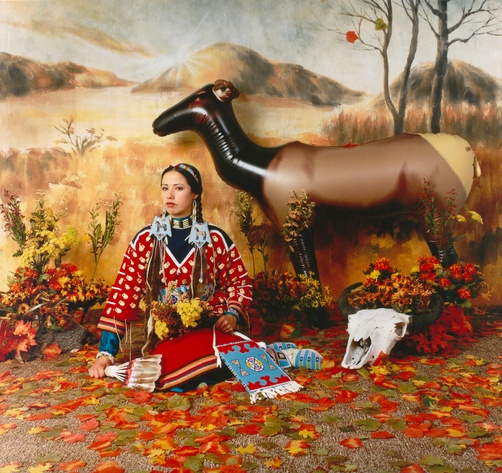On July 13, 2018, Dayton Director Ian Berry and Mellon Collections Curator Rebecca McNamara talked to Wendy Red Star about her four-part photographic series Four Seasons (2006), which was displayed in the exhibition Give a damn.
The video above shows excerpts from the interview with Red Star. A longer, edited transcript of the interview is below.
Rebecca McNamara
Can you talk about the story behind creating Four Seasons?
Wendy Red Star
I created Four Seasons in 2006 when I was a graduate student at UCLA. I was feeling homesick for my community, so I went to the Natural History Museum of Los Angeles County because I knew that I would be able to find Crow objects there. And I know that sounds messed up, and it is messed up, but I knew the one place that I could find anything of my community would be in the Natural History Museum.
The way that the building was set up, you walked under this big brontosaurus and saw all this extinction, and then you entered the Native galleries. It set people up to think of Native people as extinct. I’ve always loved dioramas, but it was uncanny how much the museum’s dioramas looked like Montana, where I’m from, but there was this sense that everything was dead here. I wanted to re-create that scene in a way where I could grapple with those feelings but also encourage viewers to step back and really think about what they’re seeing.
RM
Describe the dress you wear and your hairstyle in these photographs.
WRS
In Four Seasons, I am dressed exactly how my grandmother dressed me and how I was raised to present myself as a Crow woman. The hairstyle that I am wearing, that all Crow women wear, is to part your hair down the middle and then braid your hair over your ears. The dress is an elk-tooth dress or iichíilihtawaleiittaashte.
The elk-tooth dress is really important to Crow women. It’s a status symbol. What we’re saying by wearing the eye-teeth of an elk—there’s only two per elk—is that we have really good hunters in our family. We’re showing off the men’s ability to hunt or to trade. Or, if you’re from a well- respected family or you’re an older woman, elk teeth may be gifted to you.
During the reservation period, Crows were no longer allowed to hunt and elk were becoming extinct, so Crows started to carve the teeth out of wood or bone. Now they’re made out of resin, plastic, or sometimes glass, but they still hold that same status symbol.
RM
You’ve created these highly artificial dioramas with inflatable elk and Styrofoam snowballs, but you’re wearing your actual Crow dress. Can you talk about your use of artificiality and authenticity?
WRS
I grew up on the Crow Indian reservation, and a few years ago, it dawned on me that my family and my community is really poor. I had never associated us with poverty, but a lot of my aunts and uncles never went to college, and they’re on welfare; if you drive through our reservation you’ll see rundown houses. I think the biggest reason I didn’t think of us as poor is that we’re so culturally rich. I feel like we’re the richest people because we have our culture. Every third week in August, we have an event called Crow Fair that’s been happening since 1904. This year is the 100th Crow Fair. And you’ll see us all don our finest regalia, parade on our horses, and set up camp. It’s known as the “teepee capital of the world,” and it’s just the most beautiful thing, and it’s full of power. For me, the elk-tooth dress embodies that cultural richness and that power.






